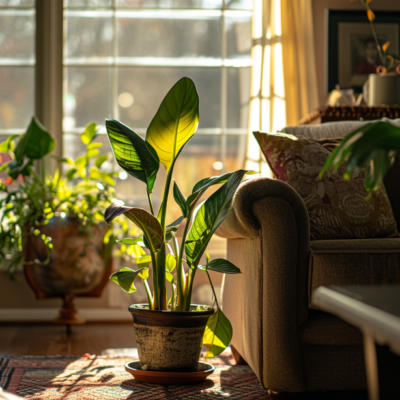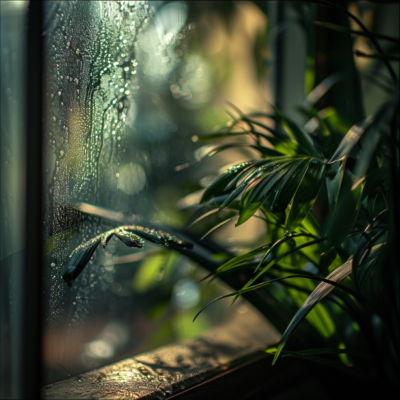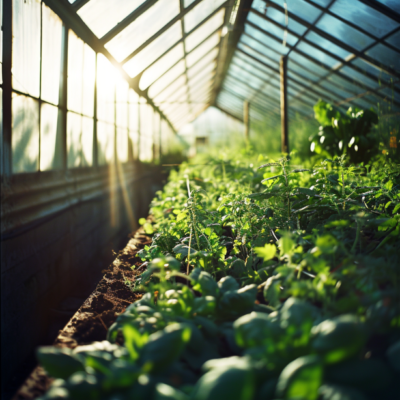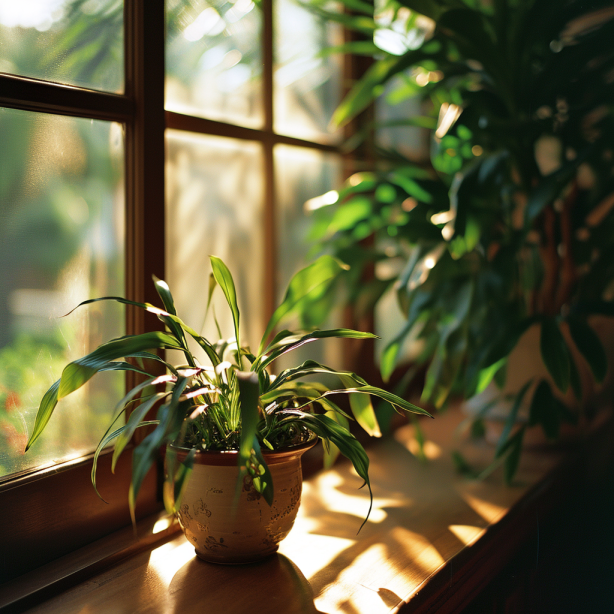According to botanist Dr. Amanda Chen, “Yes, plants can carry out photosynthesis when sunlight passes through glass.”
The glass allows visible light waves that plants need for photosynthesis to pass through.
However, glass blocks some ultraviolet rays, so a plant behind glass may photosynthesize slightly less efficiently than one getting unfiltered light.
Keep reading to discover how visible light enables photosynthesis,
Why plants might photosynthesize less efficiently behind glass,
And how much light levels drop when passing through different types of glass.
Understanding these factors can help you optimize plant growth and yield whether indoors or in a greenhouse.
Through simple adjustments, you can ensure your plants get the light they need to thrive behind glass barriers.
KEY TAKEAWAY
Can Plants Photosynthesize Through Glass?
Yes, plants can photosynthesize (1) through glass, but the efficiency may vary based on factors like glass type, window treatments, and external light conditions.
Understanding the interplay between plants and glass is crucial for optimizing indoor plant health.
A Deep Dive into Photosynthesis
Photosynthesis is the process plants use to convert light energy from the sun into chemical energy they can use as food.
It’s an important natural process that enables plants to grow and produce the oxygen we breathe.
During photosynthesis, plants use carbon dioxide, water, and light to produce glucose sugar and oxygen.
The chemical equation looks like this:
6CO2 + 6H2O + Light Energy → C6H12O6 + 6O2
This means six molecules of carbon dioxide plus six molecules of water, with light energy, produce one glucose sugar molecule and six oxygen molecules.
The light energy is absorbed by green chlorophyll pigments in plant cells.
Different wavelengths or colors of light are absorbed more efficiently depending on factors like the type of plant.
Blue and red light tend to work best.
Photosynthesis normally happens during the day when sunlight is available.
At night, plants undergo respiration where they use oxygen and glucose to produce energy and carbon dioxide.
It’s a continuous cycle that enables plants to grow and thrive.
Can Plants Photosynthesize Through Glass?
Yes, plants can carry out photosynthesis when sunlight passes through glass.
The glass allows visible light waves that plants need for photosynthesis to pass through.
So plants behind windows or in greenhouses can still convert light to energy.
However, glass blocks some ultraviolet light rays.
And it reflects over 10% of visible light.
So a plant behind glass usually photosynthesizes slightly less efficiently than one getting unfiltered natural light.
For indoor plants, placing them very close to sunny facing windows ensures they get stronger light intensity.
South-facing windows are ideal in the northern hemisphere.
Using supplemental grow lights also exposes plants to a wider spectrum of photosynthesizing light.
The amount of light blocked depends on factors like glass thickness and coatings that affect transparency.
So choose windows or windows film wisely when growing plants indoors.
Ensure they let in bright sunlight daily so your plants can carry out photosynthesis effectively.
What Are the Benefits of Photosynthesis?

Photosynthesis is hugely beneficial for life on Earth.
The oxygen it produces enables humans and other organisms to breathe.
And the glucose sugar plants feed both plants and plant-eating organisms up the food chain.
On a global scale, photosynthesis impacts the carbon cycle that regulates Earth’s climate and ecosystems.
Plants absorb carbon dioxide from the air during photosynthesis.
This helps clean the atmosphere and curb climate change driven by excess carbon dioxide from human activities like burning fossil fuels.
For the individual plant, photosynthesis enables growth and reproduction.
The glucose sugars fuel plant respiration and get converted into energy, proteins, plant tissues, and more.
A plant that can’t photosynthesize won’t last long!
Some key benefits of plant photosynthesis include:
- Producing oxygen needed for respiration
- Generating plant food/glucose to enable growth
- Cleaning the air of carbon dioxide
- Impacting carbon cycles that regulate ecosystems
- Supporting life by feeding organisms up the food chain
So next time you take a breath of fresh air or munch on a veggie, thank plant photosynthesis!
Will a Plant Photosynthesize in the Dark? What about with Artificial Light?
Plants cannot photosynthesize in the dark.
The process requires light energy which is absorbed by chlorophyll pigments.
Without exposure to light, photosynthesis shuts down.
However, many houseplants and greenhouse crops can photosynthesize under artificial grow lights.
The key is choosing bulbs that emit a color spectrum beneficial for plant growth.
Full spectrum LED and fluorescent bulbs provide a balanced share of blue and red light.
Blue light fuels leafy growth while red stimulates flowering.
Combine this with moderate levels of green and white light.
Avoid bulbs skewed heavily to yellow, orange or purple hues.
When setting up plant lights, mount them close enough to replicate outdoor light intensity.
Use timers to maintain a consistent daily photoperiod.
Test different bulbs and adjust placement until you find the artificial lighting sweet spot where your plants thrive.
While not a perfect substitute for natural sunlight, today’s grow light technologies allow many plants to carry out photosynthesis indoors.
Just ensure the light levels, spectrum and consistency meet your plants’ needs.
Light Conditions for Houseplants

Light passing through a window is not considered direct sunlight.
Direct sun means light rays shining directly onto a plant outdoors with no barrier.
Going through glass filters out over 10% of sunlight intensity.
Different window types transmit varied amounts of photosynthesizing light:
- South-facing windows allow the most light for houseplants.
- East-facing windows get good morning sun.
- West-facing windows receive hot afternoon light that can scorch plants.
- North-facing windows lack direct sun but work for low-light plants.
Glass coatings that affect transparency include:
- Low-E coatings block infrared and UV light while letting in visible light.
- Tinted glass reduces all light transmission significantly.
- Double pane glass blocks more light than single pane.
When positioning houseplants, know your window orientation and glass type to ensure plants get the right amount and quality of light.
Optimizing Natural Light for Houseplants
Photosynthesis requires light energy which fuels plant growth.
Maximizing natural light indoors optimizes photosynthesis. (2)
South-facing windows provide the most direct sun all day.
Place high light-loving plants like succulents or cacti closest to the glass.
Filter light with a sheer curtain to prevent leaf scorching.
East-facing windows get bright morning light best-suited for low to medium light plants.
Fiddle leaf figs do well in east-facing rooms.
West-facing windows can get too hot in summer but work in cooler months.
Use light meters to assess illumination levels.
Most houseplants need 10,000 to 20,000 lux.
Boost low readings with supplemental grow lights.
Rotate plants regularly so all sides get evenly lit.
This prevents plants stretching toward light on one side.
Optimizing natural light conditions allows houseplants to photosynthesize effectively year-round.
Do your homework, then leverage morning, afternoon or indirect sunlight to meet each plant’s needs.
Is Photosynthesis Affected by Season?

Yes, the rate of photosynthesis in plants changes with the seasons.
This is influenced by shifts in environmental conditions like temperature, sunlight levels, and rainfall at different times of year.
During summer, abundant light and warm weather accelerate photosynthesis.
Plants have the optimal conditions to produce more glucose energy and grow rapidly.
In winter when light is limited, photosynthesis slows down.
Deciduous trees drop leaves to conserve energy since photosynthesis isn’t efficient.
Evergreen plants like pine trees maintain green foliage year-round.
They adapt to winter light conditions by altering pigments to maximize light absorption.
Their waxy coatings also prevent water loss.
While photosynthesizing slower than summer, evergreens can still grow in winter.
The effects vary across climates and plant types.
But generally photosynthesis is most productive in the sunny, long days of spring and summer.
As light and warmth decrease, so does the rate of photosynthesis into autumn and winter.
Window Film and Its Effects on Photosynthesis
Installing window film can impact indoor plants’ ability to photosynthesize.
Films affect light transmission, which powers photosynthesis.
Potential benefits include:
- Blocking harmful UV rays that damage plants
- Reducing leaf scorching by filtering intense sunlight
- Insulating against heat/cold stress
Drawbacks to consider:
- Some films block too much visible light needed for plant growth
- Darker tints reduce light intensity significantly more than lighter or clear films
When choosing window films, know the orientation of your windows to pick appropriate light filtering levels.
Prioritize high visibility for plant-friendly south or east-facing rooms.
Add more UV blocking and heat control films for harsher western sun exposure.
Test light levels with a meter after installation to ensure your plants still get adequate light to thrive.
Frequently Asked Questions
Why are my indoor plants growing tall and spindly?
This leggy growth means your plants aren’t getting enough light.
They start reaching for sunlight to power photosynthesis.
Try moving them right up next to a sunny window, rotate frequently, or add supplemental grow lights.
What direction should my greenhouse windows face?
South-facing greenhouse glass maximizes light throughout the day.
East is second-best for ample morning sun.
North lacks direct sun but works for shade plants.
West can get extremely hot in summer.
Optimize photosynthesis with proper orientations.
Should I use low-E coated or tinted window glass in my sunroom?
Low-E coatings are better for plant growth as they block less visible light than tints.
They also reduce heat and UV rays.
For the sunroom’s warmer conditions, choose lighter tints if needed over darker ones to allow more light through.
Why are my indoor plant’s leaves turning pale or yellow?
Chlorosis or yellowing leaves often signals a nutrient deficiency.
But insufficient sunlight can also cause this symptom by reducing photosynthesis.
Try moving plants closer to windows or under grow lights before diagnosing a nutrient issue.
Conclusion
While glass blocks some UV rays, it still transmits visible light that drives photosynthesis.
So plants can carry out this essential process when sunlight passes through windows or greenhouses.
However, photosynthesis may happen at slightly lower efficiency levels compared to outdoor plants getting unfiltered light.
If growing plants indoors, optimize conditions to maximize light exposure for healthy photosynthesis:
- Place plants very close to sunny, south-facing windows
- Choose windows with high transparency levels
- Supplement with broad spectrum grow lights as needed
- Rotate plants for even lighting on all sides
With smart adjustments, indoor gardeners can ensure their plants get sufficient quality and intensity of light to thrive.
The plants will thank you with vigorous photosynthesis that supports strong, beautiful growth even behind glass!
What tips do you have for maximizing light for indoor plant photosynthesis? Share your thoughts in the comments below!
References
- https://education.nationalgeographic.org/resource/photosynthesis/
- https://www.thespruce.com/lighting-for-houseplants-1902691
Related Articles
- https://allthingsgardener.com/10-of-the-best-low-light-terrarium-plants/
- https://allthingsgardener.com/lightning-for-jade-plant-4-super-tips-will-help-you-growing-your-jade-plant-faster/
- https://allthingsgardener.com/indoor-smart-garden/




